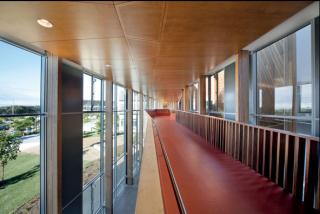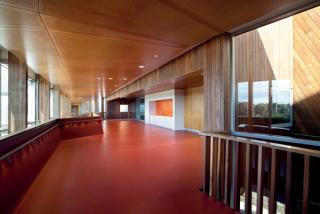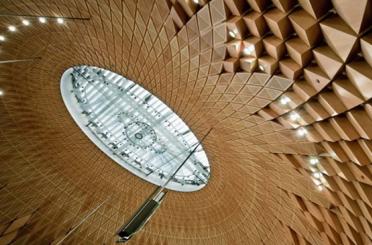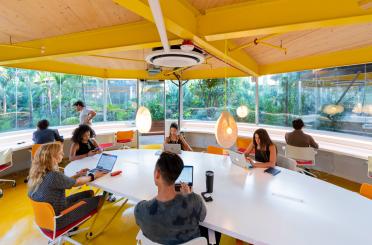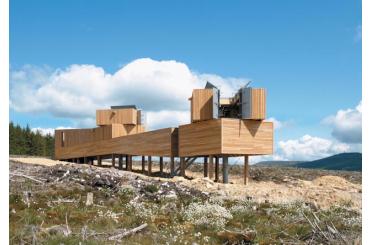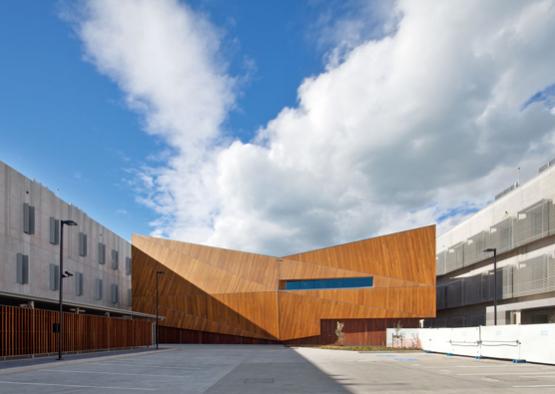
Overview
Situated in a courtyard between three storey precast concrete research buildings at the University of Wollongong Innovation Campus, this timber building houses some of the country's most powerful microscopes.
The architects Sinclair Knight Mertz (S2F) chose the primary structural system to be glue laminated timber portal frames because microscopes are highly sensitive to electromagnetic interference and any continuous structural elements in the vicinity are required to be non-ferrous.
The folded external timber façade is both sculptured and innovative, providing a textured juxtaposition to the uniformity of the adjacent concrete buildings and a welcome change to the clinical materials usually associated with leading research facilities. The façade profile is created by fixing nailed plated timber trusses vertically off the side of studs that extend the full height of the 17m tall building.
Teak was the timber species selected for the upper shell cladding, due to the close proximity to the sea and its higher weathering characteristics. Spotted Gum was selected for the base cladding for it's more intimate and tactile experience at ground level.
Internally hoop pine Interior plywood is used on all surfaces vertical surfaces. The floor has spotted gum T&G flooring. The use of timber provides a warm and tactile surface for interaction with the building's occupants.
Fire Engineering Solutions are described in Structure & Interior Tabs
Structure
The main structure of the building is framed by Tasmanian oak glulam timber portal frames. Frames consist of 900 x 130 mm beams and columns. The portal frames are connected using steel dowel epoxy into the centre of the timber elements. Again keeping with the desire to minimize the amount ferrous material being used, dowels reduce the steel needed to provide moment connection.
The roof is further framed with roof trusses consisting of hardwood elements and seasoned pine, H2 treated to provide the folded shape. Ceiling joists are generally seasoned pine MGP12 140x45 at 600 CTS, H2 treated
Floor joists are 360x63@ 450 CTS LVL, H2 treated with 2 layers of termite resistant particleboard flooring.
External wall frames are generally seasoned pine MGP12 140 x 90 at 600 CTS. Wall trusses are combined with the external stud wall to provide the folded external wall shape. These trusses consist of hardwood bottom chord, other members in the truss are seasoned pine, H2 treated.
Internal wall frames are seasoned pine MGP10 140x45 at 600 CTS, H2 treated.
Fire Information
Building Classification: Class 8 - laboratory
Rise in Storey: 2
Fire
This building is classified by the NCC as a Class 8. As the building has a Rise in Storey of 2, the building's Type of construction is C.
Fire Resistance
The use of timber in Type C buildings is not restricted. Fire resistance is provided by fire rated plasterboard or char resistance of bare timber, i.e. additional timber thickness calculated from AS 1720.4.
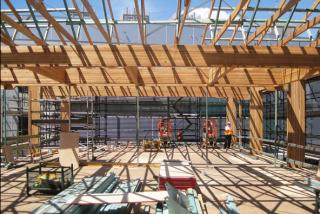
Exterior
The folded timber façade and timber cladding has been used creatively to craft a dynamic sculptured and innovative façade. Again, timber is used for the external cladding to avoid the use of ferrous materials such as steel that would generate electromagnetic interference to the microscopes.
Aesthetically, the timber cladding provides a warm and tactile surface contrasting with the uniformity of the adjacent concrete building facades. The façade features directional folds that make the building more interesting to view.
Due to the harsh environment, teak is used in the upper proportions of the building as it has high durability and stability characteristics as well as its uniform brown colour. Spotted gum is used in the base of the building for its natural deep-brown hue with streaks of blonde variation. The architects found it to be an intimate and tactile experience at ground level.
All teak and solid spotted gum cladding are coated in Cutek CD50 in a Smokey-Grey tint. "The grey tint enables the timber to look pre-weathered and fosters the natural patina of weathering as in the Japanese tradition of Wabi-sabi". Cutek CD50 oil finish requires recoating every 2 years.
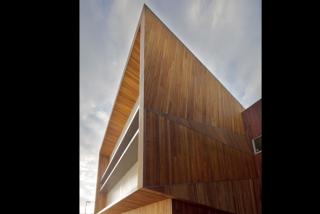
Interior
Timber finishes are used internally as an extension to the primary building structure and cladding. Again the timber internal linings contributes to the management of ferrous materials that would generate electromagnetic interference for the microscopes
Timber internal lining continued to provide a contrasting textured to the uniformity of the adjacent concrete buildings. They also provide a welcome relief to the clinical materials usually associated with leading research facilities.
Ceiling linings were provided by slotted rotary cut Hoop pine veneer panels. This was also important to enhance the acoustic absorption of the building as this is critical for the design criteria of the microscopes
Spotted gum tongue and groove lining were used on the walls, solid spotted gum was used in the bridge balustrade.
Fire Hazard Properties
Ceiling Linings
NCC's Spec C1.10 requires Class 8 building that is non sprinkled to have ceiling covering for public corridors and specifics areas, made from Material Group Number of 1 or 2. The remanding areas can be Material Group Number of 1, 2 or 3. The Hoop pine plywood panels meet Material Group 3.
Wall linings
NCC's Spec C1.10 requires Class 8 building that is non sprinkled to have wall covering for public corridors, made from Material Group Number of 1 or 2. The remanding areas can be Material Group Number of 1, 2 or 3.
Spotted gum wall innings meet Material Group 3.
Floors
NCC's Specification C1.10 Fire Hazard Properties requires Class 8 buildings not fitted with sprinklers to have floor covering with a Critical Radiant Flux of 2.2 or greater and Smoke Development Rate of less than 750 % - minute.
Floor covering are linoleum and carpet.
